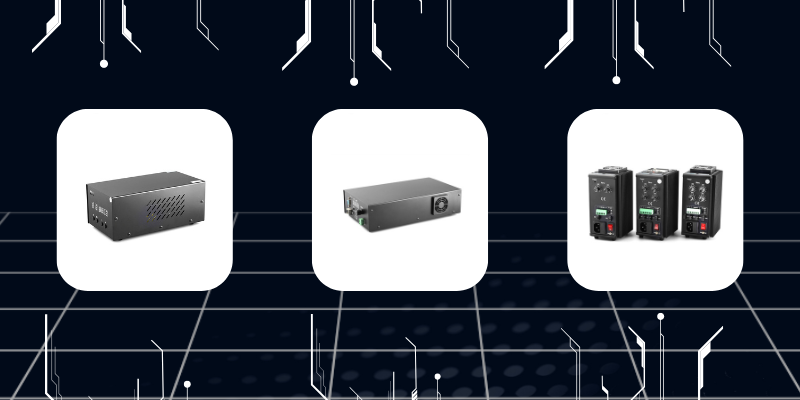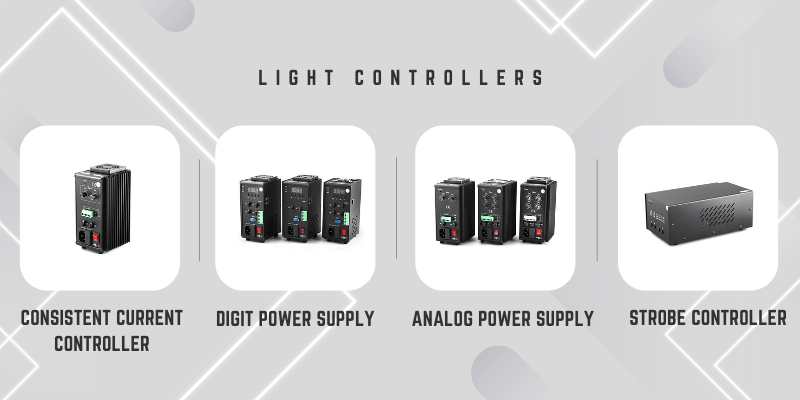

Lighting condition is, without doubt, the most crucial part of the whole machine vision system. Without proper light source, it’s impossible to obtain standard images, let alone processing and analyzing. Once you manage to have a suitable set of light source, the next step is to make sure the proper use of it and how to prolong its life as long as possible. Since light source can’t be controlled directly by CPU, that’s when lighting controller shows its power.
A lighting controller is the equipment of power supply and control the status of lighting such as strobe controller. It also can achieve the strobing by trigging signals. Just imagine the ordinary light in your house, you got a perfect lamp, now it’s time to set a dimmer in order to control it.

The basic principle of lighting controllers is I/O control system. I/O controller is a kind of media connecting industrial computer and light source. It receives the demands from industrial computers and execute them to light source and then feeds back to the industrial computer. Four types of technology is adapted in the field in order to perform the controlling process:
The I/O controller directly execute each and every demand the CPU assigns. In this way, CPU is constantly inspecting the whole working process of the lighting controller due to the simpleness of the demand written.
The demand appends “suspend” order which is used to solve the problem of constant check and inspection of the last method. When employing interrupt-driven method, I/O controller would automatically report to CPU whether it completes an order or not instead of continuous inspections.
In DMA, the systems works as “bulks”, which means the data is generated into bulks. Amount of data, the position the data is stored in and other related information contained in each bulk are previously provided by CPU. Therefore, the data can be transformed directly between RAM and the equipment without the help of CPU. DMA will report back to CU when the whole data in a bulk is completed.
CPU informs the process and how to execute it to the controller, the controller can finish the job alone. When the job is done, the controller can report to CPU through the “suspend” order we mentioned earlier. In this way, CPU doesn’t need to be involved as much as the first two methods. The utilization is drastically improved.
All those mentioned methods are heading towards the same path which is to free CPU from boring and simple tasks in order to process more complicated programs. That’s why the last one is one of the most popular techniques adopted by the industry.
When it comes to choosing a suitable lighting controller, here’s several important parameters you should take a look at.
Each lighting controller has its own supported voltage/ electric current. It is often related to the light source you apply. The common choices of output voltage in the field of machine vision are 5V, 12V, 24V and 28V.
This parameter is directly related to the number of light sources connected to the lighting controller. In short, it refers to the number of light sources a controller can control.
As we mentioned before, a lighting controller is like a dimmer of a commercial light. However, in the complicated industrial scenarios, different light sources usually requires different types of lighting controller. We’ll introduce the specific details of lighting controllers and their separated advantages in the following section.

In the current market, there are several universal lighting controllers which can be divided into 5 types:
Analog power supply
Analog power supply needs to be adjusted manually. The word “analog” refers to the analog signal the lighting controller adopted in the control site in order to supply power. It is the most common way to adjust the brightness of light sources manually. The analog controller itself has no specific levels of the lighting brightness control, but it has short-circuit protection function when using. Thus, the safety performance of the product can still be effectively guaranteed.
Advantages:
Digit power supply
Different from analog power supply, digit power supply refers to the digital signal for supplying power. Since the digit power supply supports the function of being controlled by industrial computers, it needs to set up the program in advance to control the brightness of different intensity of light source in different scenarios. Digital controller as a whole has a high degree of integration, in addition to its own short-circuit protection and other basic functions, it also can connect to the computer to the light source brightness flexible control.
Advantages:
Strobe controller
A strobe controller supports light source twinkling in certain frequency to coordinate with the imaging of industrial cameras. You can’t spot conspicuous differences from its appearance. However, the difference of principles between a strobe controller and others is that the former starts light sources by drastically elevating current in a short time, usually less than 1ms. Since strobe controllers are specifically designed for twinkling in certain frequency, they actually don’t support the light source to light up in long time which will end up hurting the controller.
Advantages:
Constant (high power) current controller
The output current is stable and constant with changing voltage. A specific module is implanted inside of the controller in order to achieve the constant current output. Why on earth do we need to make sure outputting constant current? That’s because it results in stable and constant brightness of light sources which is crucial in certain industries.
Advantages:
With all being mentioned in the article, I’m sure you have the basic knowledge of lighting controllers including how it works and the differences of several common types of them. Here at SmartMoreInside, we provide all those mentioned products. If you have any other doubts about how to select the perfect one, don’t worry. We also prepare a clear set of costume services to guide you through the whole process of selection. With SmartMoreInside, we can make a smarter future.
Email format error
Email cannot be empty
Email already exists
6-20 characters(letters plus numbers only)
The password is inconsistent
Email format error
Email cannot be empty
Email does not exist
6-20 characters(letters plus numbers only)
The password is inconsistent